Avro Lincoln
| Lincoln | |
|---|---|
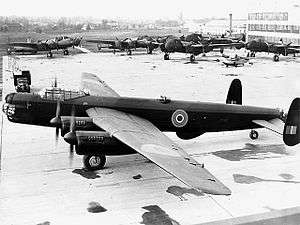 | |
| The only Canadian built Avro Lincoln | |
| Role | Heavy bomber |
| Manufacturer | A V Roe (168), Metropolitan-Vickers (80) and Armstrong Whitworth (281) |
| First flight | 9 June 1944 |
| Introduction | 1945 |
| Retired | 1967 Argentine Air Force |
| Primary users | Royal Air Force Argentine Air Force Royal Australian Air Force |
| Number built | 624 |
| Developed from | Avro Lancaster |
| Developed into | Avro Shackleton Avro Tudor |
The Avro Type 694, better known as the Avro Lincoln, was a British four-engined heavy bomber, which first flew on 9 June 1944. Developed from the Avro Lancaster, the first Lincoln variants were known initially as the Lancaster IV and V but were renamed Lincoln I and II. It was the last piston-engined bomber used by the Royal Air Force.
The Lincoln became operational in August 1945. It had been assigned to units of Tiger Force, a Commonwealth heavy bomber force, intended to take part in the Second World War Allied operations against the Japanese mainland but the war ended before the Lincoln was used in combat. The Lincoln was used in action during the 1950s, by the RAF in the Mau Mau Uprising in Kenya and with the RAF and RAAF during the Malayan Emergency.
The type also saw significant service with the Royal Australian Air Force (RAAF) and the Argentine Air Force (Spanish: Fuerza Aérea Argentina), as well as some civil aviation use.
In RAF service, the Lincoln was replaced by jet bombers, chiefly the English Electric Canberra, as well as the three strategic bombers of Britain's V Force – the Vickers Valiant, Handley Page Victor and the Avro Vulcan. In Argentine service it was also replaced by the Canberra.
Design and development
The Avro Lincoln was Roy Chadwick's development of the Lancaster, built to the Air Ministry Specification B.14/43, having stronger, longer span, higher aspect ratio (10.30 compared with 8.02) wings with two-stage supercharged Rolls-Royce Merlin 85 engines in Universal Power Plant (UPP) installations and with a bigger fuselage with increased fuel and bomb loads, allowing it to carry up to 4.5 tons of various armaments and equipment fittings. As a result of these changes, the Lincoln had a higher operational ceiling and longer range than the Lancaster, having a maximum altitude of 35,000 ft (6.5 miles) and a maximum range of 4450 miles.[1][2]
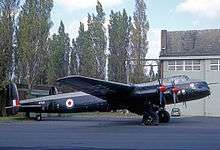
The prototype Lancaster IV (Lincoln I) was assembled by Avro's experimental flight department at Manchester's Ringway Airport and made its maiden flight from there on 9 June 1944.[2][3] Production of the type was primarily performed at Avro's Woodford, Cheshire and Chadderton, Lancashire factories; additional aircraft were also constructed by Armstrong Whitworth at their Coventry facilities. Separate production lines were also set up in Canada and Australia, although with the end of the war, production in Canada (by Victory Aircraft) was halted after only one aircraft had been built. Production in Australia proceeded, the Lincolns that were subsequently manufactured there were operated by the Royal Australian Air Force (RAAF).
One Lincoln B Mk XV pattern aircraft was also completed in Canada by Victory Aircraft; a follow-up order for a total of six RCAF variants was cancelled shortly following the end of hostilities.[4] Along with two additional (Mk I and Mk II) aircraft on loan from the RAF, the type was briefly evaluated postwar by the RCAF.[5] The Lancaster V/Lincoln II differed mainly in that it was fitted with Merlin 68A engines.
Before the Lincoln was developed, the Australian government intended its Department of Aircraft Production (DAP), later known as the Government Aircraft Factory (GAF), would build the Lancaster Mk III. In its place, a variant of the Lincoln I, re-designated as Mk 30, was manufactured between 1946 and 1949; it has the distinction of being the largest aircraft ever built in Australia.[6] Orders for a total of 85 Mk 30 Lincolns were placed by the RAAF (which designated the type A-73), although only 73 were ever produced.[7]
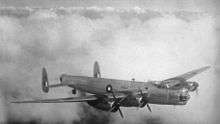
The first five Australian examples (A73–1 to A73–5), were assembled using British-made components. On 17 March 1946, A73-1 conducted its début flight; the first entirely Australian-built Lincoln, A73-6, was formally delivered in November 1946. The Mk 30 initially featured four Merlin 85 engines, this arrangement was later changed to a combination of two outboard Merlin 66s and two inboard Merlin 85s. A further improved later version, designated as Lincoln Mk 30A, featured a total of four Merlin 102s.
During the 1950s, the RAAF heavily modified some of their Mk 30 aircraft to perform anti-submarine warfare missions, re-designating them GR.Mk 31. These examples had a 6 ft 6 in (1.98 m) longer nose to house acoustic submarine detection gear and its operators, larger fuel tanks to provide the aircraft with a 13-hour flight endurance and a modified bomb bay to accommodate torpedoes. The Mk 31 was particularly difficult to land at night, as the bomber used a tailwheel and the long nose obstructed the pilot's view of the runway. 18 aircraft were rebuilt to this standard in 1952, gaining new serial numbers.[6] Ten were subsequently upgraded to MR.Mk 31 standard, which included an updated radar. These Lincolns served with No. 10 Squadron RAAF at RAAF Townsville; however, the discovery of corrosion in the wing spars led to the type's premature retirement in 1961.[8]
The Avro Shackleton maritime patrol aircraft was derived from the Lincoln, as was the Tudor airliner, which used the wings of the Lincoln with a new pressurised fuselage.
Operational history


Royal Air Force
The first RAF Lincolns joined No. 57 Squadron at East Kirby in 1945. No. 75 (New Zealand) Squadron RAF began re-equipping with Lincolns at RAF Spilsby during August 1945. However, 75 (NZ) Sqn received just three aircraft before VJ Day.
In the postwar Royal Air Force, the Lincoln equipped many bomber squadrons. Nearly 600 Lincolns were built to equip 29 RAF squadrons, mainly based in the United Kingdom. They were partially replaced by 88 Boeing Washingtons, on loan from the USAF, which had longer range and could reach targets inside the Iron Curtain. Small numbers remained in use with Nos 7, 83 and 97 Squadrons until the end of 1955, when they were replaced by the first of the V bombers.
RAF Lincolns were used in combat during the 1950s, in Kenya against the Mau-Mau, operating from Eastleigh, and also served in Malaya during the Malayan Emergency, against insurgents aligned to the Malayan Communist Party. In Malaya, Lincolns operated from Changi and Tengah, More than 3,000 sorties were flown during their 7 1⁄2-year deployment, with half a million pounds of bombs dropped. This equated to 85% of the bomb tonnage dropped during the Malayan emergency.[8]
On 12 March 1953, a RAF Lincoln (RF531 "C") of Central Gunnery School was shot down 20 mi (32 km) NE of Lüneburg, Germany by several Soviet MiG-15s as it flew to Berlin on a radar reconnaissance flight,[9] resulting in the deaths of the seven crew members.
In November 1955, four Lincolns of No. 7 Squadron RAF were detached for duties in British territories in the Middle East. In Bahrain, they carried out border patrols of the then Trucial States. When 7 Sqn was disbanded in December 1955, the four detached crews and aircraft became No. 1426 Flight RAF, officially a photographic reconnaissance unit. It was later sent to Aden, carrying out patrols in the lead up to the Aden Emergency.
As the RAF Lincolns became unserviceable due to wear and tear, they were replaced by jet aircraft. The Lincolns of Bomber Command were phased out from the mid-1950s and were completely replaced by jet bombers by 1963. The last Lincolns in RAF service were five operated by No. 151 Squadron, Signals Command, at RAF Watton, Norfolk, which were retired on 12 March 1963.[10][11]
Royal Australian Air Force
From late 1946, Australian-built Lincolns were phased into No. 82 Wing RAAF at RAAF Amberley, replacing the Consolidated Liberators operated by 12, 21 and 23 Squadrons. In February 1948, these units were renumbered 1, 2 and 6 Squadrons respectively; a fourth RAAF Lincoln squadron, No. 10 was formed on 17 March 1949 at RAAF Townsville as a reconnaissance unit.
RAAF Lincolns took part in operations in Malaya in the 1950s, operating alongside RAF examples. The RAAF based the B.Mk 30s of No.1 Squadron at Tengah, for the duration of operations in Malaya.[8]
The RAAF Lincolns were retired in 1961, with the MR.Mk 31s of No. 10 Squadron being the final variant to see service in Australia.
Argentine Air Force
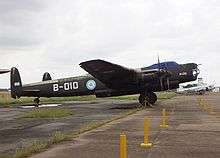
The Lincoln served with the Fuerza Aerea Argentina from 1947: 30 aircraft were acquired (together with 15 Lancasters),[12][13] giving Argentina the most powerful bombing force in South America.[14] Eighteen of these were newly built, along with twelve ex-RAF aircraft. The Lincolns entered service with I Grupo de Bombardeo of V Brigada Aérea in 1947. Eleven remained in use at the beginning of 1965, but most were retired during the next year. The last examples were retired in 1967.[15]
The Argentine aircraft were used in bombing missions against rebels, during the attempted military coup of September 1951 and by both the government and rebel forces during the 1955 Revolución Libertadora coup that deposed Juan Perón.[16]
Lincolns were also used to drop supplies in support of Argentine operations in the Antarctic.[17] One of the bombers was returned to Avro in 1948 for modification at Langar to allow it to operate Antarctic support flights, including the addition of Lancastrian nose and tail cones, additional fuel tanks, and removal of armament, becoming the first Avro Lincolnian.[12][18] The aircraft was civilian registered and named Cruz del Sur; it undertook its first airdrop supply flight to the Antarctic San Martín Base in December 1951.[18][19]
Use in aero-engine research
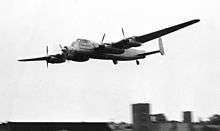
Lincolns were frequently employed as testbeds in new jet engine development. RF403, RE339/G and SX972 flew with a pair of Armstrong Siddeley Python turboprops outboard in place of the Merlins, and was used for the ballistic casing drop-test programme for the Blue Danube atomic weapon.[20] SX972 was further modified to fly with a pair of Bristol Proteus turboprops. RA716/G had a similarly placed pair of Bristol Theseus turboprops and later also flew with Rolls-Royce Avon turbojets replacing the pair of turboprops. Lincoln Test Bed RF530 kept its Merlins but had a Napier Naiad turboprop in the nose. It later flew, bearing the civilian "Class B" test registration G-37-1, with a similarly placed Rolls-Royce Tyne which it displayed at the 1956 Society of British Aircraft Constructors (SBAC) show, making a low level flypast on just the nose Tyne, the four Merlins being shut down and propellers feathered.[21]SX973 had a Napier Nomad diesel turbo-compound installed in a similar nose-mounted installation.[22] RA643 flew with a Bristol Phoebus turbojet in the bomb bay, and SX971 had an afterburning Rolls-Royce Derwent mounted ventrally.[23]
Commercial service
Two Lincoln IIs were operated by D. Napier & Son Ltd. for icing research from 1948 to 1962. A transport conversion of the Lincoln II, using the streamlined nose and tail cones of the Lancastrian and a ventral cargo pannier, was known as the Avro 695 Lincolnian.
One Lincoln Freighter converted by Airflight Ltd was used on the Berlin Air Lift by Surrey Flying Services Ltd.
Four Lincolnian conversions by Field Aircraft Services for use as meat haulers in Paraguay were not delivered and subsequently scrapped.
Variants
- Avro Type 694
- Prototypes to Air Ministry Specification 14/43, three-built
- Lincoln I
- Long-range bomber version for the RAF. Powered by four 1,750 hp (1,305 kW) Rolls-Royce Merlin 85 inline piston engines.
- Lincoln II
- Long-range bomber version for the RAF. Powered by four Rolls-Royce Merlin 66, 68A and 300 inline piston engines. Built by Avro, Armstrong-Whitworth and Vickers-Metropolitan
- Lincoln III
- The Lincoln III was intended to be a maritime reconnaissance, anti-submarine warfare aircraft. The aircraft later became the Avro Shackleton.
- Lincoln IV
- Lincoln II converted to Merlin 85 power.
- Lincoln Mk 15 (B Mk XV)
- This designation was given to one aircraft, built by Victory Aircraft in Canada.
- Lincoln Mk 30
- Long-range bomber version for the RAAF.
- Lincoln Mk 30A
- Long-range bomber version for the RAAF, fitted with a longer nose and Australian manufactured Merlin 102s.
- Lincoln Mk 31 (GR 31)
- General reconnaissance version of Mk.30 for the RAAF, fitted with a longer nose.[24] Four Rolls-Royce Merlin 85 or 1,650 h.p. Merlin 102 powerplants.
- Lincoln MR 31
- Anti-submarine warfare/maritime reconnaissance version of Mk 31 for the RAAF.[24]
- Avro 695 Lincolnian
- Transport derivative similar to the Avro Lancastrian
- Lincoln ASR.3.
- Initial designation of the Avro Shackleton, which was based on the Lincoln.
Operators
- Argentine Air Force
- I Grupo de Bombardeo of V Brigada Aerea.
- Fuerza Aerea de Tareas Antarticas (FATA)
- Royal Australian Air Force – 54 Avro Lincolns were in service with the RAAF from 1946 to 1961.[24]
- No. 1 Squadron RAAF
- No. 2 Squadron RAAF
- No. 6 Squadron RAAF
- No. 10 Squadron RAAF
- No. 12 Squadron RAAF (redesignated No. 1 Squadron in 1948)
- Heavy Bomber Crew Conversion Unit RAAF
- Lincoln Conversion Flight RAAF
- Royal Canadian Air Force
- Three Avro Lincolns were in service with the RCAF from 1946 to 1948.
- Royal Air Force
- No. 7 Squadron RAF 1949–55 at RAF Upwood.[25]
- No. 9 Squadron RAF 1946–52 at RAF Binbrook, converted to the English Electric Canberra.[25]
- No. 12 Squadron RAF 1946–52 at RAF Binbrook and RAF Hemswell, converted to the English Electric Canberra.[25]
- No. 15 Squadron RAF 1947–50 at RAF Wyton, converted to the Boeing Washington.[25]
- No. 35 Squadron RAF 1949–50 at RAF Mildenhall.[25]
- No. 44 Squadron RAF 1945–51 at RAF Mildenhall and RAF Wyton, converted to the Boeing Washington.[25]
- No. 49 Squadron RAF 1949–55 at RAF Upwood, RAF Waddington and RAF Wittering.[25]
- No. 50 Squadron RAF 1949–51 at RAF Waddington.[25]
- No. 57 Squadron RAF 1945–51 at RAF West Kirby, RAF Elsham Wolds, RAF Scampton, RAF Lindholme and RAF Waddington, converted to the Boeing Washington.[25]
- No. 58 Squadron RAF 1951 at RAF Benson[25] and RAF Wyton[9]
- No. 61 Squadron RAF 1946–54 at RAF Waddington and RAF Wittering, converted to the English Electric Canberra.[25]
- No. 75 (New Zealand) Squadron RAF 1945 at RAF Spilsby.[25]
- No. 83 Squadron RAF 1945–55 at RAF Coningsby and RAF Hemswell.[25]
- No. 90 Squadron RAF 1947–50 at RAF Wyton, converted to the Boeing Washington.[25]
- No. 97 Squadron RAF 1946–55 at RAF Coningsby and RAF Hemswell.[25]
- No. 100 Squadron RAF 1946–54 at RAF Lindholme, RAF Hemswell, RAF Waddington and RAF Wittering, converted to the English Electric Canberra.[25]
- No. 101 Squadron RAF 1946–51 at RAF Binbrook, converted to the English Electric Canberra.[25]
- No. 115 Squadron RAF 1949–50 at RAF Mildenhall.[25]
- No. 116 Squadron RAF 1952–54 at RAF Watton
- No. 138 Squadron RAF 1947–60 at RAF Wyton and RAF Scampton.[25]
- No. 148 Squadron RAF 1950–55 at RAF Upwood.[25]
- No. 149 Squadron RAF 1949–50 at RAF Mildenhall.[25]
- No. 151 Squadron RAF 1962–63 at RAF Watton
- No. 192 Squadron RAF 1951–53 at RAF Watton
- No. 199 Squadron RAF 1951–57 at RAF Watton and RAF Hemswell, converted to the Vickers Valiant
- No. 207 Squadron RAF 1949–50 at RAF Mildenhall.[25]
- No. 214 Squadron RAF 1950–54 at RAF Upwood.[25]
- No. 230 Operational Conversion Unit RAF 1949–1953 at RAF Lindholme and RAF Upwood, became the Bomber Command Bombing School
- No. 527 Squadron RAF 1952–57 at RAF Watton
- No. 617 Squadron RAF 1946–52 at RAF Watton, converted to the English Electric Canberra.[25]
- No. 1321 Flight RAF 1954–58 at RAF Hemswell
- No. 1426 Flight RAF 1956–57 at RAF Khormaksar
- No. 1689 Flight RAF 1951–52 at RAF Aston Down
- Bomb Ballistic Unit 1947–48 at RAF Woodbridge
- Bomber Command Bombing School (BCBS) 1952–1960 at RAF Scampton and RAF Lindholme, converted to the Handley Page Hastings
- Central Navigation and Control School 1951–55 at RAF Shawbury
- Coastal Command Gunnery School 1955 at RAF Leconfield
- Empire Air Navigation School 1947–48 at RAF Shawbury
- Empire Air Navigation School 1946–50 at RAF Manby
- Empire Central Flying School 1945–46 at RAF Hullavington
- Empire Radio School 1947–50 at RAF Debden
- Radar Research Flight 1951–57 at RAF Wyton
- Flight Refuelling Ltd (FRL) – used some converted as tankers for flight refuelling
- Empire Test Pilots School
Accidents and incidents
Aircraft on display
Argentina
- On display
- Lincoln II B-004 – on display as B-010 at the National Museum of Aeronautics, Buenos Aires.[26]
- Lincoln II B-016 – a gate guardian at the Villa Reynolds airbase, San Luis Province.[26][27]
Australia
- Stored or under restoration
- Lincoln II RF342 In storage for future restoration at the Australian National Aviation Museum, Melbourne.[26]
United Kingdom
- On display
- Lincoln II RF398 at the Royal Air Force Museum Cosford.[26]
Specifications (Lincoln I)
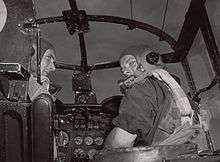
.jpg)
Data from Aircraft of the Royal Air Force 1918–57 [28]
General characteristics
- Crew: 7 (pilot, flight engineer/co-pilot, navigator, wireless operator, front gunner/bomb aimer, dorsal and rear gunners)
- Length: 78 ft 3½ in (23.86 m)
- Wingspan: 120 ft (36.58 m)
- Height: 17 ft 3½ in (5.27 m)
- Wing area: 1,421 ft² (132.01 m²)
- Empty weight: 43,400 lb (19,686 kg)
- Loaded weight: 75,000 lb (34,020 kg)
- Max. takeoff weight: 82,000 lb [29] (37,195 kg)
- Powerplant: 4 × Rolls-Royce Merlin 85 V piston engine, 1,750 hp (1,305 kW) each
Performance
- Maximum speed: 319 mph (513 km/h) at 18,800 (5,730 m)
- Cruise speed: 215 mph (346 km/h) at 20,000 ft (6,096 m)
- Range: 2,930 mi (4,714 km) with maximum bomb-load 1,470 miles (2,365 km) [N 1]
- Service ceiling: 30,500 ft (9,296 m)
- Rate of climb: 800 ft/min (245 m/min)
Armament
- Guns: 2 × .50 in (12.7 mm) M2 Browning machine guns in nose and tail turrets, and dorsal turret with either twin .50 in machine guns or twin 20 mm Hispano cannon.
- Bombs: Up to 14,000 lb (6,400 kg) of bombs [7] (normal maximum). Exceptionally one 22,000 lb (10,000 kg) DP bomb.[33]
See also
- Related development
- Aircraft of comparable role, configuration and era
- Boeing B-29 Superfortress
- Boeing B-50 Superfortress
- Consolidated B-32 Dominator
- Heinkel He 277
- Messerschmitt Me 264
- Tupolev Tu-4
- Vickers Windsor
- Related lists
References
Notes
- ↑ The Lincoln was capable of the following ranges with a 14,000 lb bomb load: 2,800 miles at 15,000 ft and 200 mph; 2,240 miles at 20,000 ft and 260 mph. The Lincoln was capable of the following ranges with a 6,000 lb bomb load: 4,000 miles at 15,000 ft and 200 mph; 3,430 miles at 20,000 ft and 260 mph.[30] Using the Merlin 102 engine, an RAAF Lincoln was able to take off in 2,874 ft with an all up weight of 82,000 lb.[31] A lightened Lincoln, using Merlin 114 engines, and carrying a rocket assisted bomb similar in size and weight to a 12,000 lb Tallboy bomb, was able to achieve 42,000 ft.[32]
Citations
- ↑ Nathan, Stuart. "February 1946: the last of the piston-engined bombers." The Engineer, 4 February 2015.
- 1 2 Delve 2005, p. 249.
- ↑ Scholefield 1998, p. 37.
- ↑ "Avro Lincoln." Archived December 5, 2010, at the Wayback Machine. airforce.forces.gc.ca. Retrieved: 30 August 2010.
- ↑ "Avro Lincoln." rcaf.com. Retrieved: 30 August 2010.
- 1 2 Jackson 1990, p. 412.
- 1 2 "A73 Avro Lincoln." RAAF Museum, Point Cook. Retrieved: 30 August 2010.
- 1 2 3 World Aircraft Information Files, 1997.
- 1 2 http://www.spyflight.co.uk/linc.htm
- ↑ Jackson 1990, p. 406.
- ↑ "Avro Lincoln B2." Royal Air Force Museum, Retrieved: 3 March 2015.
- ↑ Marino et al. 2001, p. 65.
- ↑ Marino et al. 2002, p. 37.
- ↑ Marino et al. 2002, p. 41.
- ↑ Marino et al. 2002, pp. 40–41.
- ↑ Marino et al. 2002, p. 39.
- 1 2 "A 61-year Operation Link, the first FAA flight over Antarctica." aeroespacio, Retrieved: 29 December 2012.
- ↑ "Avro 694 Lincoln modificado Cruz del Sur." asociacionatta.com. Retrieved: 29 December 2012.
- ↑ The National Archives, London, file ES 1/44.
- ↑ "No. 4610. Avro 694 Lincoln B. Mk. II (G-37-1)." Maurice Collier Collection. Retrieved: 26 December 2009.
- ↑ Grant 2003
- ↑ Franks 2000, pp. 97–99.
- 1 2 3 Wilson, Stewart (1994). Military Aircraft of Australia. Weston Creek, Australia: Aerospace Publications. p. 216. ISBN 1875671080.
- 1 2 3 4 5 6 7 8 9 10 11 12 13 14 15 16 17 18 19 20 21 22 23 24 Delve 2005, p. 251.
- 1 2 3 4 "Individual History: Avro Lincoln B.2 RF398/8376M – Museum Accession Number 84/A/1182." Royal Air Force Museum, 2012.
- ↑ "33°44'00.0"S 65°23'00.0"W." Google Maps, Retrieved: 3 May 2015.
- ↑ Thetford 1957, p. 65.
- ↑ Jackson 1990, p. 411.
- ↑ Flight Magazine, 26 January 1946, p. 59.
- ↑ Garbett and Goulding 1979, p. 95.
- ↑ Garbett and Goulding 1979, p. 70.
- ↑ Mason 1994, p. 357.
Bibliography
- Buttler, Tony. Avro Lincoln (Warpaint series no. 34). Denbigh East, Bletchley, UK: Hall Park Books, 2000.
- Delve, Ken. Bomber Command: 1936–1968: An Operational & Historical Record. Pen and Sword, 2005. ISBN 1-47381-259-3.
- Franks, Richard A. The Avro Lancaster, Manchester and Lincoln. Bedford, United Kingdom: SAM Publications, 2000. ISBN 0-9533465-3-6.
- Garbett, Mike and Brian Goulding. Lincoln at War. Shepperton, Surrey, UK: Ian Allan Ltd, 1979. ISBN 0-7110-0847-7.
- Grant, Jim. Lincoln Test Beds Model Aircraft Monthly, Volume 2 Issue 11, November 2003, SAM Publications, ISSN 1475-3405
- Jackson, A.J. Avro Aircraft since 1908, 2nd edition. London: Putnam Aeronautical Books, 1990. ISBN 0-85177-834-8.
- Lake, Alan. Flying Units Of The RAF. London: Airlife Publishing Ltd, 1999. ISBN 1-84037-086-6.
- Lake, Jon. Type Analysis: Avro Lincoln International Air Power Review, Volume 1, 1997, Airtime publishing. ISSN 1473-9917.
- Marino, Atilo, Vladimiro Celleto and Javier Mosquera. "Argentina's 'Heavies': Avro Lancaster, Lincoln and Lancastrian in Military Service: Part One." Air Enthusiast, No. 95, September/October 2001, pp. 64–70. Stamford, UK. Key Publishing. ISSN 0143-5450.
- Marino, Atilo, Vladimiro Celleto and Javier Mosquera. "Argentina's 'Heavies': Avro Lancaster, Lincoln and Lancastrian in Military Service: Part Two." Air Enthusiast, No. 97, January/February 2002, pp. 36–43. Stamford, UK. Key Publishing. ISSN 0143-5450.
- Mason, Francis K. The British Bomber since 1914. London: Putnam, 1994. ISBN 0-85177-861-5.
- Scholefield, R.A. Manchester Airport. Stroud, Gloucestershire, UK: Sutton Publishing, 1998. ISBN 0-7509-1954-X.
- Thetford, Owen. Aircraft of the Royal Air Force 1918–57. London: Putnam, 1957.
- Wilson, Stewart. Lincoln, Canberra and F-111 in Australian Service. Weston Creek, ACT, Australia: Aerospace Publications, 1989. ISBN 0-9587978-3-8.
- World Aircraft Information Files, File # 022. London: Bright Star Publishing Ltd, 1997.
Further reading
- Benedetto, Fernando (2009). Núñez Padin, Jorge Felix, ed. Avro Lancaster, Lancastrian & Lincoln. Serie Fuerza Aérea (in Spanish). 17. Bahía Blanca, Argentina: Fuerzas Aeronavales. ISBN 978-987-1682-00-3.
External links
| Wikimedia Commons has media related to Avro Lincoln. |
- Avro Lincoln in World War II
- Avro Lincoln articles and publications
- Avro Lincoln B2
- The Avro Lincoln – Flight archive – 1946
- Lincoln flying over Lincoln Cathedral